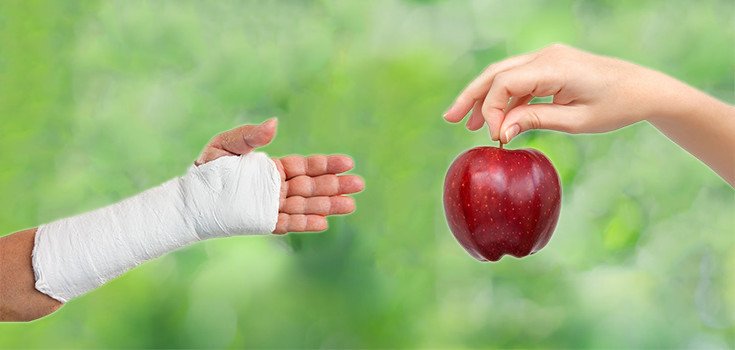6 Tips for Speeding up Bone Fracture Healing

Whether you are a grade school student or a highly-paid professional athlete, a bone fracture can be a tremendous inconvenience that may involve weeks or months of healing and muscular re-training, especially if the fracture is treated with nothing more than a cast. Is there a better way? Here are the latest techniques that could speed up bone fracture healing and reduce the stress from injury.
Treating Fractures with Ultrasound and Electromagnetic Field Therapy
1. and 2. Low intensity pulsed ultrasound (LIPUS) and pulsed electromagnetic field therapy (PEMF) are two options used by a number of athletes for promoting repair. A review of 8 studies has noted that both of these treatments can be effective in speeding tibial fracture healing.
One of the papers reviewed found a reduction in healing time of 12 days among non-smokers treated with LIPUS (84 days versus 96 days) for clinical healing, and a reduction of 33 days for healing with PEMF (96 days instead of 129). Even in smokers using these therapies healing time is reduced, 103 days versus 175 in the control group using LIPUS and 96 days versus 175 in the control group using PEMF.
In another of the studies, this time evaluating fractures of the radius in the arm, the effects of LIPUS treatment on patients receiving 15 minutes of therapy per day were measured. For patients in the treatment group, clinical fracture healing time was 32 days on average, as opposed to 40 days in the placebo group.
Mechanical stimulation with whole body vibration may be another effective way to enhance bone healing and muscle strength, though results vary with the level of frequency and amplitude used.
Boosting Nutrition for Bone Fracture Healing
Besides these treatment methods, there are also nutritional considerations that can greatly speed up bone fracture healing. A 90 year old woman is said to have healed her broken pelvis with carrot juice, showing how important nutrition is to bones and overall health.
- 3. One nutritional intervention is increasing caloric intake. For example, a normally active adult may need 2,500 calories daily, but a patient with multiple fractures may need up to 6,000 calories per day, even if they are bedridden! More specifically, research has shown that elderly hip fracture patients with low protein levels (albumin under 3.5g/dL) are almost 3 times more likely to have a hospital stay of over 2 weeks, and 4 times more likely to die within the next year.
- 4. It is recommended to increase protein intake in fracture patients by 20 grams daily, as one study found that patients receiving a protein supplement remained in rehabilitation wards for 33 days as opposed to 54 days for the group receiving a placebo of similar caloric value. These patients also had greater increases of growth factor IGF-1, which is necessary for healing in bone fracture patients, and they experienced less than half of the loss in bone mineral density and half as many vertebral deformities compared to controls.
- 5. Micronutrients can also play a role in fracture healing. For example, an antioxidant vitamin E deficiency can disrupt maintenance of calcium stores, resulting in overactive parathyroid glands and bone loss. In animal studies, antioxidant administration completely prevented bone loss in mice with their ovaries removed, while inhibiting glutathione synthesis (the “master antioxidant”) resulted in a significant level of bone loss in mice with intact ovaries.
- 6. Vitamin C, an antioxidant that often works with glutathione, may inhibit the bone destroying osteoclasts and sustain the growth of the bone building osteoblasts, by mechanisms such as upregulating collagen type I synthesis. Collagen synthesis is also essential for bone fracture healing in and of itself. Certain pro-oxidant and inflammatory chemicals such as TNF-alpha, hydrogen peroxide, nuclear factor kappa-B, IL-8, IL-1 and IL-6 are known to work against bone building in support of the osteoclasts. Therefore, anti-inflammatory nutrients and herbs like
turmeric may assist in healing.
However, certain types of inflammation can benefit bone healing, therefore non-steroidal anti-inflammatory drugs (NSAIDs) should be avoided as much as possible in favor of alternatives including vitamin C (500mg), quercetin, and bromelain. Of course, calcium, magnesium and vitamin D are always indispensable in bone growth and repair, but silicon supplementation as an adjunct may increase the rate of healing, though absorption rates vary.
While it is therefore possible to speed fracture healing, information on this is not always provided to patients, so it is important to pass this on if someone you know is currently recovering from a fracture.

Nice article. Now a days technology is also playing a quite nice role in medical science. Ultrasound And Electromagnetic Field Therapy also effects on bacteria and yeast cells. Fracture healing is a highly complex regenerative process that is essentially a replay of developmental events. These events include the action of many different cell types, a myriad of proteins, and active gene expression that in the majority of cases ultimately will restore the bone’s natural integrity.
nice article.and a best remedy